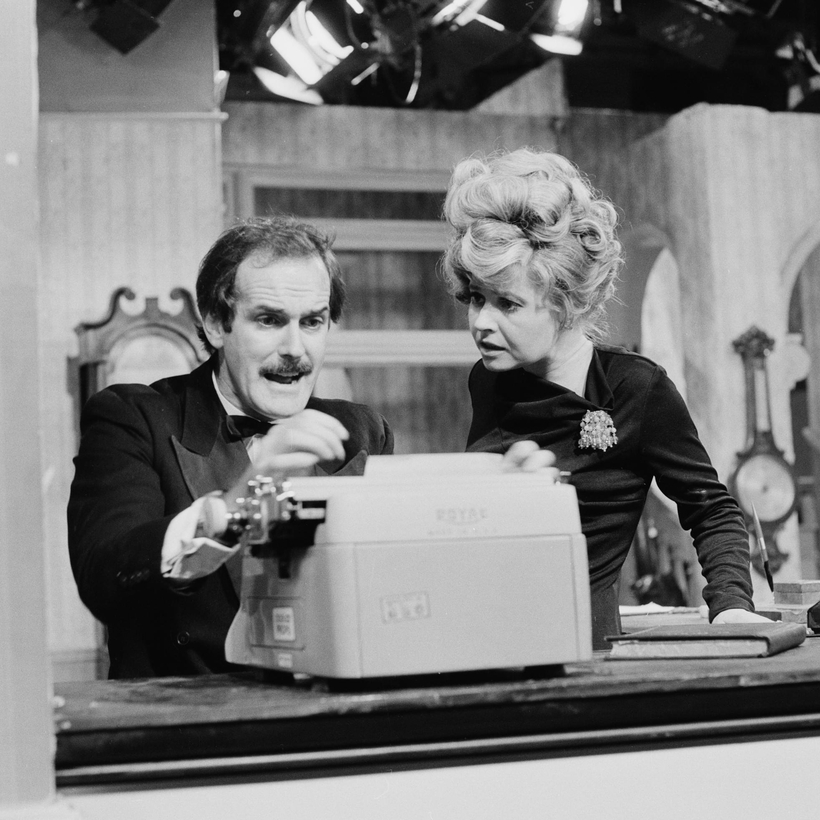In a student house in middle England 50 years ago this weekend, three of my classmates and I waited agog to see John Cleese’s first TV show since he left the Monty Python troupe the previous year. We had all been Python fanatics since we were 14 years old, knew most of the sketches verbatim, and were very excited indeed.
The comedy premiered on the secondary, minority BBC channel, and within minutes—seconds, in truth—we were very much not laughing. The episode was about a fake Lord trying to check in to a seedy seaside hotel, and the snobbish Cleese character who runs the place gets fooled by him.
Where was the surrealism? Where were the intellectual in-jokes about Hobbes, Kant, and Heidegger? The sketches with no traditional end? The bizarre animations? In short, where was all the stuff from Monty Python that our parents hated and we consequently loved all the more?

Instead, in this Fawlty Towers monstrosity, we saw the most distinctive and ingenious Python playing a grumpy hotelier in a lame farce. There wasn’t even a random British Army officer striding onto the set to say it’s all getting too silly.
Fawlty Towers was as much of a cultural shock in 1975 as it would have been to see Bob Dylan hosting a game show or Jack Nicholson becoming a televangelist. It appeared to be very much a comedic dead parrot. Put another Python-esque way: it really was too silly. And just plain wrong.
The critics echoed the bottomless disappointment my classmates and I felt. In the second episode, “The Builders,” the penny-pinching, gangling Basil Fawlty hires a cheap and incompetent clunking stereotype of an Irish builder to do some work, but tells his wife he’s given the job to her more expensive and capable choice. It was met with the same near-universal indifference, with the then influential Daily Mirror tabloid headlining its review, “Long John Short on Jokes.”
Decades later, we know the BBC hated Fawlty Towers, too, when co-creators Cleese and his wife, Connie Booth (who also plays Polly, the American waitress), submitted it. A report unearthed in the 1990s on the pilot script read, “I’m afraid I thought this one as dire as its title. It’s a kind of ‘Prince of Denmark’ of the hotel world. A collection of clichés and stock characters which I can’t see being anything but a disaster.”
It was championed by only one channel boss, who, Cleese has since said, may have been too polite to turn the show down in the wake of the raging success of Monty Python’s Flying Circus—that show aired for four seasons between 1969 and 1974.
Fast-forward, then, half a century to the Apollo Theatre in the West End earlier this month, where a packed Thursday-matinée crowd—average age about 70, at a guess—roared with laughter at the Cleese-approved Fawlty Towers stage show, now in its 10th year.

Sweet, still wonderfully funny, and immaculately done, it’s an odd sort of theatrical farce because practically the entire audience knows every line by heart. It’s more like a pop concert than a comedy, except we didn’t quite sing along.
Nor is Fawlty Towers: The Play the only Fawlty by-product in town. A few blocks away, an embarrassingly awful dinner show with audience participation, Faulty [sic] Towers The Dining Experience, has been running for 13 years. In Australia, where the show originated, and more than 40 other countries, it’s been going for 28 years. It is very much not approved by Cleese, but has survived legally nonetheless.
Of all the cultural smash hits of 1975—a list that includes Jaws, The Rocky Horror Picture Show, Queen’s Bohemian Rhapsody, One Flew Over the Cuckoo’s Nest, and Saturday Night Live—a cheaply made English sitcom is surely the least likely to be raking in millions 50 years later, especially when the series only ran for a total of 12 28-minute episodes.
But back in the 1970s, something odd had happened to our perception of Fawlty Towers. When the first six episodes were re-run by the BBC a few months after that inauspicious launch, everyone who hated it suddenly loved it. No matter how deeply one peers into one’s soul, it’s impossible to describe the pathology of finding something previously unfunny funny. The repeats drew an audience of 12 million—equivalent to roughly 60 million in the U.S., where it was yet to launch and become a PBS favorite.
By the mid-1980s, once it had taken off among select U.S. audiences, Fawlty Towers was almost universally regarded as among the three or four greatest television comedies of all time. On some lists, it ranks better than Seinfeld, Curb Your Enthusiasm, and The Simpsons. Fans have emerged as diverse as Martin Scorsese, President George Bush Sr., King Charles, Kurt Vonnegut, Leonard Bernstein, Jimmy Carter, and even Margaret Thatcher, who was not known for her sense of humor.
Fawlty Towers’ elevation from fringe flop to global paragon of situation comedy is all the more curious for three things. One is that it is so firmly rooted in the class-based subtleties of a provincial English snob who has pretensions but no money, breeding, talent, or connections, making the show almost impossible to repackage for a wider global audience.
You can find on YouTube, if you dare, episodes of the 1983 American version of Fawlty Towers, Amanda’s by the Sea, which starred Bea Arthur of The Golden Girls and premiered on ABC. Why, you may wonder, is a female actor the star? Because the Basil character, who had been the entire core of Fawlty Towers, was dropped as being too acerbic and unappealing for U.S. viewers. Amanda’s by the Sea was almost literally Hamlet without the prince, and the network dropped it after only a few episodes.
There were other American versions, too: Chateau Snavely, a pilot that was never picked up, with Harvey Korman as the Basil equivalent and Betty White as the Sybil, both good names at the time; and Payne, made in 1999 with John Larroquette as Royal Payne, that show’s version of Basil. Payne was canceled after nine episodes on CBS.
The second oddity about Fawlty Towers is that, ragingly popular as it continues to be (I even come across Gen Z fans, particularly in the U.S.), it couldn’t possibly be made today.

After seeing the stage version, I noted that even though it has been lightly bowdlerized to remove the most heavily racist terms—those, it should be added, were written ironically by Cleese and Booth—it still manages to mercilessly make fun of: old people, senile people, women, people who don’t speak English well, people with disabilities, Irish people, American people, German people, working-class people, and upper-class people. It’s not a show that, if new, would fit in well with the raging culture wars of today, but it doesn’t seek new, young audiences.
The third element that makes Fawlty Towers peculiar is that it’s an almost textbook rendition of a man on the verge of a catastrophic breakdown. If Basil Fawlty was your husband or father, you would be really concerned and send for a psychiatrist right away. But as the great English playwright Alan Ayckbourn has wisely said, “A comedy is just a tragedy interrupted.”
If you think about it, nobody in the comedy canon is sadder, more unfulfilled, more underachieving, more hopeless, more pathetic, and more tragic than Basil Fawlty. And therein lies the magic and Olympian endurance of Fawlty Towers.
Based in London and New York, AIR MAIL’s tech columnist, Jonathan Margolis, spent more than two decades as a technology writer at the Financial Times. He is also the author of an unauthorized biography of John Cleese that was published in 1992 to mixed reviews. It is still available if you look very, very hard


